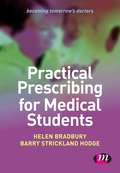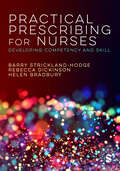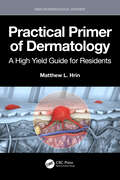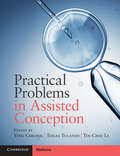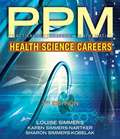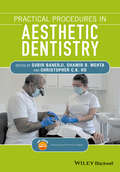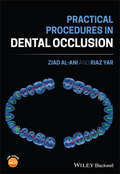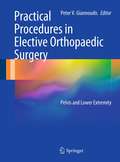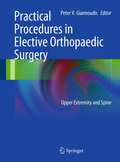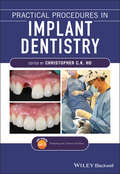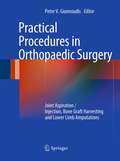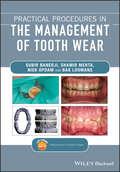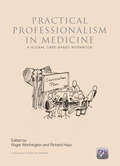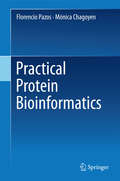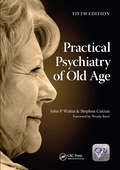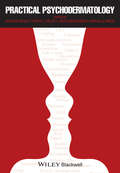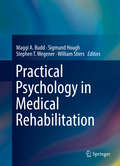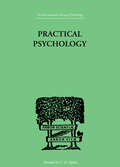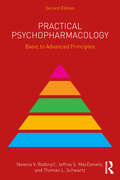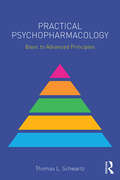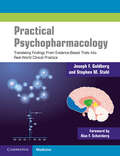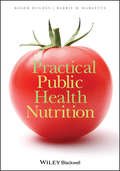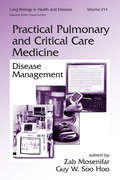- Table View
- List View
Practical Prescribing for Medical Students (Becoming Tomorrow's Doctors Series)
by Mrs Helen Bradbury Barry Strickland HodgeLearning to prescribe is an essential part of medical training. Due to various high profile serious prescribing errors, the GMC have introduced stricter prescribing standards which medical students must meet in order to graduate. This book helps medical students learn the essentials of safe prescribing practice, and is aimed directly at their needs. It covers all the aspects of prescribing required by the GMC, including principles of prescribing, law and ethics, professional responsibilities, patient communication, at-risk groups, avoiding common errors and what to do when things go wrong. Key features: Directly linked to the prescribing competencies in the GMC's Tomorrow's Doctors and Good Practice in Prescribing Medicines Real-life prescribing case studies and scenarios relate the principles to actual practice and placement situations Activities throughout each chapter for testing prescribing knowledge and skills Test questions for the new Prescribing Skills Assessment to help students prepare and be confident that they can pass.
Practical Prescribing for Nurses: Developing Competency and Skill
by Rebecca Dickinson Helen Bradbury Barry Strickland HodgePreparing nurses for prescribing with a complete overview of the knowledge, theory and skills for safe and effective practice. This accessible and engaging textbook covers the full spectrum of knowledge from the policy and legal aspects of working with medicines, through to the pharmacology of drugs as well as the practical skills required to make a diagnosis and work effectively with patients. It is structured around the Royal Pharmaceutical Society framework for all prescribers and the Nursing and Midwifery Council Standards of Proficiency for Registered Nurses. A complete resource that will ensure students are fully prepared and ready to prescribe.
Practical Prescribing for Nurses: Developing Competency and Skill
by Rebecca Dickinson Helen Bradbury Barry Strickland HodgePreparing nurses for prescribing with a complete overview of the knowledge, theory and skills for safe and effective practice. This accessible and engaging textbook covers the full spectrum of knowledge from the policy and legal aspects of working with medicines, through to the pharmacology of drugs as well as the practical skills required to make a diagnosis and work effectively with patients. It is structured around the Royal Pharmaceutical Society framework for all prescribers and the Nursing and Midwifery Council Standards of Proficiency for Registered Nurses. A complete resource that will ensure students are fully prepared and ready to prescribe.
Practical Primer of Dermatology: A High Yield Guide for Residents (Series in Dermatological Treatment)
by Matthew L. HrinStudying for boards is straightforward, but clinical competence relies on experience and this guide is designed to accelerate that.It’s amazing how much one can know, and still not know what to do. This is likely, at least in part, due to the fact that many existing resources are not usually oriented toward the practical aspects of patient care. For instance, a book might say, for traction alopecia, a patient should adopt looser hairstyles, but it might not explain how to counsel a patient on what they need to communicate to their loctician to achieve lower tension. While acing exams and having a strong knowledge fund are necessary, they alone are not sufficient; one could spend all day memorizing the properties and minutiae of sutures, be able to answer every test question about them correctly, and yet still not know what to do when a knot repeatedly slips in a tight area. Boards answers don’t always necessarily hold in real-world contexts either; obtaining a DIF specimen perilesionally for bullous pemphigoid (classic exam answer) wouldn’t be the appropriate site if there were no bullae. The list of examples of conventional information failing to translate to successful clinical practice are endless.This book provides practical pearls to fill these gaps and emphasizes the areas that are the most crucial for trainees to prioritize early on. It is a compilation of insights from several well-recognized leaders in dermatology and dermatologic surgery. Practical Primer of Dermatology is written in a succinct, conversational style and is a perfect read for residents, medical students, and non-dermatology physicians.
Practical Problems in Assisted Conception
by Togas Tulandi Tin-Chiu Li Ying CheongEngage with practical and active solutions to day-to-day issues of reproductive medicine and the use of artificial reproductive techniques (ART), occurring in clinical and laboratory environments. Authored by leading experts in the field, this user-friendly guide is invaluable for any IVF practitioner and embryologist, facing everyday hands-on issues, through to high-pressure laboratory problems, efficiency ratings and ensuring cost-effective delivery of care. With the strict governance of regulatory bodies worldwide, the success of any fertility centre depends on successful problem solving, all day every day. Based on a wealth of experience, identify commonly occurring problems, and fresh perspectives of problem-solving, with 'must-have' protocols, patient information sheets and suggested equipment. This go-to companion tackles operational, organisational, clinical and laboratory issues to financial and clinical governance, with a focus on quick and effective solutions for the busy practitioner.
Practical Problems in Mathematics for Health Science Careers
by Karen Simmers-Nartker Louise Simmers Sharon Simmers-KobelakPRACTICAL PROBLEMS IN MATHEMATICS FOR HEALTH SCIENCE CAREERS, 3RD EDITION familiarizes readers in Allied Health programs with essential math processes using real-life examples and straightforward instruction. Using a word problem format, this text starts with simple examples and progresses to complex paradigms to ensure readers are engaged throughout each chapter. In addition to basic applications with whole numbers, fractions, and decimals, problems involving medications, intravenous solutions, and other emulsions information are also featured on common graphs, charts, and gauges. Thoroughly updated and expanded, Practical Problems In Mathematics For Health Science Careers, 3rd Edition provides a strong foundation in the essential math processes used in all areas of health care.
Practical Procedures in Aesthetic Dentistry
by Christopher C. Ho Shamir B. Mehta Subir BanerjiPractical Procedures in Aesthetic Dentistry presents a comprehensive collection of videos demonstrating clinical techniques in aesthetic and restorative dentistry, and is accompanied by a handbook summarising the key points of each procedure. Interactive website hosting over nine hours of video Accompanying illustrated handbook summarising key points Expert teaching across a comprehensive range of aesthetic and restorative procedures International team of contributors with clinical and academic expertise
Practical Procedures in Dental Occlusion
by Ziad Al-Ani Riaz YarPRACTICAL PROCEDURES IN DENTAL OCCLUSION A robust and accessible resource on occlusion for general dental practitioners Practical Procedures in Dental Occlusion delivers a solid and reliable exploration of dental occlusion. The book offers practical and accessible information about evidence-based techniques applicable to everyday clinical situations encountered in general practice. The authors provide a straightforward guide to the optimisation of restorative treatment outcomes, including occlusion in simple and advanced restorative care. The inclusion of questions at the end of the book, a glossary of useful terms and phrases in occlusion encourages self-assessment. Readers will also find: Thorough introductions to common prosthodontic terms, neuromuscular philosophies, and the equipment and techniques used in occlusal examination Practical explorations of typical problems faced by practitioners when recording occlusal contacts using different articulating papers Overviews of “high crown” clinical scenarios, including the importance of opposing alginate impressions and cast mounting An insightful treatment of the clinical scenario of a fractured upper central incisor composite restoration Perfect for undergraduate dental students and general dental practitioners, Practical Procedures in Dental Occlusion is a valuable resource for those seeking a systematic and logical treatment of the management of occlusal problems.
Practical Procedures in Elective Orthopaedic Surgery: Pelvis and Lower Extremity
by Peter V. GiannoudisWith the time available to surgeons-in-training ever dwindling, there is great emphasis placed on practical learning tools. Mirroring his earlier book on practical procedures in trauma surgery, Prof Giannoudis has produced a reference in more elective techniques. In most medical schools, most emphasis is placed on orthopaedic trauma surgery, with elective techniques often delayed until much later in a surgeon's training.
Practical Procedures in Elective Orthopaedic Surgery: Upper Extremity and Spine
by Peter V. GiannoudisWith the time available to surgeons-in-training ever dwindling, there is great emphasis placed on practical learning tools. Mirroring his earlier book on practical procedures in trauma surgery, Prof Giannoudis has produced a reference in more elective techniques. In most medical schools, most emphasis is placed on orthopaedic trauma surgery, with elective techniques often delayed until much later in a surgeon's training.
Practical Procedures in Implant Dentistry
by Christopher C. K. HoMaster the fundamentals and intricacies of implant dentistry with this comprehensive and practical new resource Practical Procedures in Implant Dentistry delivers a comprehensive collection of information demonstrating the science and clinical techniques in implant dentistry. Written in a practical and accessible style that outlines the principles and procedures of each technique, the book offers clinical tips and references to build a comprehensive foundation of knowledge in implantology. Written by an international team of contributors with extensive clinical and academic expertise, Practical Procedures in Implant Dentistry covers core topics such as: Rationale and assessment for implant placement and restoration, including the diagnostic records and surgical considerations required for optimal planning and risk management Incision design considerations and flap management, with an essential knowledge of regional neuro-vascular structures Implant placement, encompassing the timing of the placement, bone requirements and understanding the importance of the peri-implant interface for soft tissue stability Impression techniques, loading protocols, digital workflows and the aesthetic considerations of implants Prosthetic rehabilitation of single tooth implants to fully edentulous workflows, including discussions of soft tissue support, biomechanics and occlusal verification Perfect for both general dental practitioners and specialists in implant dentistry, Practical Procedures in Implant Dentistry is also a valuable reference to senior undergraduate and postgraduate dental students.
Practical Procedures in Orthopaedic Surgery
by Peter V. GiannoudisThis highly illustrated text book will be an essential guide for surgeons in training, providing step by step approaches to performing Joint Aspiration/Injection, Bone Graft Harvesting and Lower Limb Amputations. Practical guidance will be given on Indications- Preoperative assessment, positioning and preparing the patient, approach required, tips and tricks, closure, postoperative complications, protocol of mobilization and follow-up procedure. All the procedures performed will include numerous intraoperative photographs and illustrations.
Practical Procedures in Orthopaedic Trauma Surgery
by Peter V. Giannoudis Hans-Christoph PapeThis highly illustrated textbook provides an essential guide for surgeons in training. It follows a step-by-step approach to performing a surgical procedure. It includes details of positioning the patient, the approach and reduction technique, the implant to be inserted, protocols for postoperative mobilization, complications to look for, when the patient should be seen in the outpatient clinic and whether the implant should be removed. Intraoperative pictures have been incorporated to make the surgeon aware of all the important issues involved. It covers the most common trauma procedures that surgeons in training are expected to perform during their residency. Each procedure has been written by an expert. This will be an invaluable resource for the resident in training during the long on-call nights in the hospital while preparing for the operations necessary to help trauma patients.
Practical Procedures in the Management of Tooth Wear
by Shamir B. Mehta Subir Banerji Niek Opdam Bas LoomansNew to the Practical Procedures in… series, Practical Procedures in the Management of Tooth Wear demonstrates a wide range of up to date clinical techniques in the practical management of tooth wear. Presented in an accessible and user-friendly format, the book summarises the key points of each procedure, complete with clinical photographs. Chapters outline the principles and procedures for each technique, offer clinical tips and advice, and include full references. Topics include patient assessment and diagnosis, treatment planning for localised and generalised tooth wear, the partially dentate patient, tooth wear monitoring, management, and maintenance. Created by an internationally-recognised team with both clinical and academic expertise, this valuable resource: Presents comprehensive, evidence-based coverage of the management of tooth wear Examines the epidemiology and etiology of tooth wear Covers practical aspects such as record taking, aesthetic evaluation, prevention, clinical occlusion and active monitoring Includes access to high quality instructional videos to further supplement the text. Practical Procedures in the Management of Tooth Wear is a unique source of information for general dental practitioners, senior undergraduate dental students, and postgraduates preparing for higher qualifications and training.
Practical Professionalism in Medicine: A Global Case-Based Workbook
by Richard Hays Roger P. WorthingtonDoctors in training are exposed to pressures and distractions to which they do not always respond appropriately, and individuals and institutions can struggle to deal effectively with difficulties when they arise. This book exposes the myths surrounding medical professionalism and strips it of pretensions or exclusivity, making a complex subject accessible and easy to comprehend. It promotes best practice for dealing with unprofessional behaviours amongst doctors-in-training. Divided into two main sections, this workbook first explores topics such as what constitutes professionalism, how it might best be taught and assessed, the interactions between professionalism, ethics and legal frameworks, international trends in medical education in relation to professionalism and implications for public policy. The second section presents 29 international case studies based on real life, explores issues and makes practical recommendations. Medical educators and students will appreciate the common format with key discussion points for each case and international health and social care professionals will welcome inspiration from the candid, sincere exploration of the topic.
Practical Protein Bioinformatics
by Florencio Pazos Mónica ChagoyenThis book describes more than 60 web-accessible computational tools for protein analysis and is totally practical, with detailed explanations on how to use these tools and interpret their results and minimal mentions to their theoretical basis (only when that is required for making a better use of them). It covers a wide range of tools for dealing with different aspects of proteins, from their sequences, to their three-dimensional structures, and the biological networks they are immersed in. The selection of tools is based on the experience of the authors that lead a protein bioinformatics facility in a large research centre, with the additional constraint that the tools should be accessible through standard web browsers without requiring the local installation of specific software, command-line tools, etc. The web tools covered include those aimed to retrieve protein information, look for similar proteins, generate pair-wise and multiple sequence alignments of protein sequences, work with protein domains and motifs, study the phylogeny of a family of proteins, retrieve, manipulate and visualize protein three-dimensional structures, predict protein structural features as well as whole three-dimensional structures, extract biological information from protein structures, summarize large protein sets, study protein interaction and metabolic networks, etc. The book is associated to a dynamic web site that will reflect changes in the web addresses of the tools, updates of these, etc. It also contains QR codes that can be scanned with any device to direct its browser to the tool web site. This monograph will be most valuable for researchers in experimental labs without specific knowledge on bioinformatics or computing.
Practical Psychiatry of Old Age, Fifth Edition
by John Wattis Stephen CurranMulti-disciplinary in its approach, this book details key psychiatric conditions, their assessment and management in line with modern developments, including the latest developments in healthcare policy. It has been thoroughly revised to incorporate the National Institute for Health and Clinical Excellence (NICE) Guidance.Case studies are used throughout to aid comprehension and illustrate the realities of working in this area.Now in its Fifth Edition, Practical Psychiatry of Old Age is ideal as a clinical primer for those in training, or as a day-to-day reference for healthcare professionals working with older people.
Practical Psychodermatology
by Ruth E. Taylor Jason S. Reichenberg Anthony Bewley Michelle MagidThe aim of Practical Psychodermatology is to provide a simple, comprehensive, practical and up-to-date guide for the management of patients with psychocutaneous disease. The scope of the book will be inclusive and will aim to cover all aspects of psychocutaneous disease, in an accessible way so that non-dermatologists and non-psychiatrists will be easily able to understand the text.The book will apply a practical facilitative approach to diagnosis and management, and will be summarised by clear boxed texts and algorithms to assist readers. In addition there will be a reference and website section at the end of each chapter to which the reader can refer for more in depth study.
Practical Psychology in Medical Rehabilitation
by Maggi A. Budd Sigmund Hough Stephen T. Wegener William StiersThis easy-access guide summarizes the dynamic specialty of rehabilitation psychology, focusing on real-world practice in the medical setting. It begins by placing readers at the frontlines of practice with a solid foundation for gathering information and communicating effectively with patients, families, and staff. The book's topics run a wide gamut of patient conditions (neurological, musculoskeletal, cardiovascular), related problems (sleep and fatigue issues, depression) and practitioner responses (encouraging coping and compliance, pediatric and geriatric considerations). Models of disability and adaptation, review of competency concerns, and guidelines for group and individual therapy offer evidence-based insights for helping patients manage their health conditions, benefit from rehabilitation interventions, and prepare for their post-rehabilitation lives and activities. Coverage spotlights these core areas: #65533;Basics and biopsychosocial practicalities, from behavioral medicine and psychopharmacology to ethical and forensic issues. #65533;Populations, problems, and procedures, including stroke, TBI, substance abuse, transplants, and severe mental illness. #65533;Assessment and practical interventions such as pain, anxiety, cognitive functioning, and more. #65533;Consultation, advocacy, and interdisciplinary teams. #65533;Practice management, administration, and professional self-care. #65533;Research, technology, and program evaluation. Practical Psychology in Medical Rehabilitation is an essential professional development tool for novice (and a refresher for veteran) psychologists and neuropsychologists, as well as rehabilitation physicians, nurses, therapists, psychiatrists, and social workers. It presents in depth both the hallmarks of the specialty and the nuts and bolts of being a valuable team player in a medical setting.
Practical Psychology: FOR STUDENTS OF EDUCATION (International Library Of Psychology Ser.)
by Fox, CharlesFirst Published in 1999. Routledge is an imprint of Taylor & Francis, an informa company.
Practical Psychopharmacology: Basic to Advanced Principles (Clinical Topics in Psychology and Psychiatry)
by Thomas L. Schwartz Nevena V. Radonjić Jeffrey S. MacDanielsPractical Psychopharmacology, 2nd ed, takes the novel approach of writing at three different levels—beginning, intermediate, and advanced—to give the practicing psychopharmacologist a tailored experience.Each chapter focuses on a specific DSM-5TR disorder and outlines abbreviated treatment guidelines to help the reader understand where their knowledge base and clinical practice currently reside. At the first level, the book teaches novice prescribers practical diagnostic skills and provides a brief overview of pertinent genetic and neuroimaging findings to increase prescribing confidence. Next, it provides mid-level clinicians with intermediate techniques and guidelines for more difficult cases. The final level provides nuanced guidance for advanced practitioners or those who see the most treatment-resistant patients.This approach allows a clinician to access this book periodically throughout the care of an individual patient and to gradually progress through a series of more advanced psychopharmacological techniques for making accurate and efficient diagnoses.
Practical Psychopharmacology: Basic to Advanced Principles (Clinical Topics in Psychology and Psychiatry)
by Thomas L. SchwartzPractical Psychopharmacology takes the novel approach of writing at three different levels—beginning, intermediate, and advanced—to give the practicing psychopharmacologist a tailored experience. Each chapter focuses on a specific DSM-5 disorder and outlines abbreviated treatment guidelines to help the reader understand where their knowledge base and clinical practice currently resides. At the first level, the book teaches novice prescribers practical diagnostic skills and provides a brief overview of pertinent genetic and neuroimaging findings to increase prescribing confidence. Next, it provides mid-level clinicians with intermediate techniques and guidelines for more difficult cases. The final level provides nuanced guidance for advanced practitioners or those who see the most treatment-resistant patients. This approach allows a clinician to access this book periodically throughout the care of an individual patient and to gradually progress through a series of more advanced psychopharmacological techniques for making accurate and efficient diagnoses. Readers can also visit the book’s eResource page to download a bonus chapter on eating disorders as well as case studies and multiple-choice questions for each chapter.
Practical Psychopharmacology: Translating Findings From Evidence-Based Trials into Real-World Clinical Practice
by Stephen Stahl Joseph GoldbergDespite the lack of guidance available for practitioners, extensive polypharmacy has become the primary method of treating patients with severe and chronic mood, anxiety, psychotic or behavioral disorders. This ground-breaking new book provides an overview of psychopharmacology knowledge and decision-making strategies, integrating findings from evidence-based trials with real-world clinical presentations. It adopts the approach and mind-set of a clinical investigator and reveals how prescribers can practice 'bespoke psychopharmacology', tailoring care to the individualized needs of patients. Practitioners at all levels of expertise will enhance their ability to devise rationale-based treatments, targeting manifestations of dysfunctional neural circuitry and dimensions of psychopathology that cut across conventional psychiatric diagnoses. Presented in a user-friendly, practical, full-colour layout and incorporating summary tables, bullet points, and illustrative case vignettes, it is an invaluable guide for all healthcare professionals prescribing psychotropic medications, including psychiatry specialists, primary care physicians, and advanced practice registered nurses.
Practical Public Health Nutrition
by Roger HughesProviding the reader with a practice-focussed approach to public health nutrition intervention management, Practical Public Health Nutrition is a crucial resource for dietitians, community and public health nutritionists and related health professionals in need of a practical guide to practicing public health nutrition. Internationally recognised experts Hughes and Margetts describe in detail the rationale, processes and tools that can be used to assess population needs, analyse problems and develop effective interventions at a community level. Exercises in each section of the book contribute to a collective PHN intervention plan, providing the reader with the opportunity to demonstrate an outcome of intervention management. Unique in its approach to teaching the practical applications of this increasingly crucial discipline, Practical Public Health Nutrition is a vital purchase for anyone working in the public health arena. Clearly outlines the practice of PHN intervention management Covers rationale, processes and tools needed to develop effective interventions at community level Written by 2 internationally respected authorities on the discipline of Public Health Nutrition Essential text for dietitians, community and public health nutritions and related health professionals
Practical Pulmonary and Critical Care Medicine: Disease Management
by Zab Mosenifar Guy W. Soo HooIncluding previously unpublished guidelines and recent care descriptions not available in any other text, this reference provides illustrative chapters on the identification, diagnosis, and management of commonly encountered diseases and conditions in the care of the critically-ill patient. Researching the most recent clinical trials and supplying
